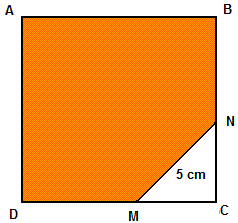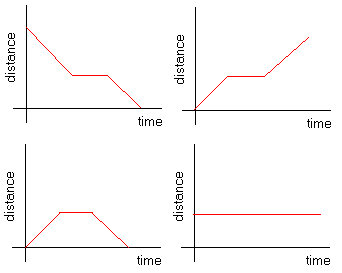Solution
We first convert the time of 4 hours 41 minutes in minutes
4 hours 41 minutes = 4 × 60 + 41 = 281 minutes
Average speed S is given by distance / time. Hence
S = 281 miles / 281 minutes = 1 mile / minute
= 60 miles / hour
Solution
Number of people whose age is less than 20 is given by
120 - 90 = 30
Probability P that a person selected at random from the group is less than 20 is gieven by
30 / 120 = 0.25
Solution
Let L be the length and W be the width of the rectangle. Hence
L = 4 W
We now use the area to write
100 = L × W
Substitute L by 4 W in the equation above
100 = 4 W × W = 4 W2
Solve for W and find L
4 W2 = 100
W2 = 25 , W = 5 and L = 4 W = 20 m
Solution
Out of the 6 possible numbers that may rolled, 3 are even: 2, 4 and 6 BUT only 4 and 6 are greater than 2. Hence the probability that the number rolled is an even number greater than 2 is given by
(number of even numbers greater than 2) / 6 = 2 / 6 = 1 / 3
Solution
A translation of 2 units up will increase the y coordinate by 2 units and a translation by 5 units to the left will decrease the x coordinate by 5. Hence after these translations point (2,2) becomes
(2 - 5 , 2 + 2) = (-3 , 4)
When point (-3 , 4) is reflected in the x axis, its y coordinate changes sign and point (-3 , 4) becomes
(-3 , -4)
Solution
If L and W be the original length and width of the rectangle and its area is given by
L × W
After increase the length becomes 2 L and the width becomes 3 W. The area is then given by (2 L) × (3 W) and is known. Hence
(2 L) × (3 W) = 1800
Solve the above equation to find L × W
6 L × W = 1800
L × W = 1800 / 6 = 300 square meters , area of original rectangle
Solution
Let x be the length of the edge of the original cube. When increased to twice its original size it becomes 2 x which gives a volume of
2x × 2x × 2x = 8x3
The volume is known. Hence
8x3 = 64,000
x3 = 8,000 which gives x = 20
The area of one face of the original (before the increase) is given by x2
x2 = 202 = 400 square centimeters
Solution
In 1 hour pump A can fill 1/5 of a tank and pump B can fill 1/8 of the same tank. So in 1 hour the two pumps working together can fill
1/5 + 1/8 = 13 / 40 of a tank
Since the rate of the two pumps working together is 13/40, the time t needed to fill the tank by the two pumps is found by solving
(13/40) t = 1
t = 40 / 13 = 39/13 + 1/13 hours
= 3 hours and (1/13)*60 minutes
= 3 hours 5 minutes (rounded to the nearest minute)
Solution
The volume of a rectangular prism is given by
area of base × height
The rate at which the tank is being filled is 1 liter per minute which we need to convert
1 liter = 1 dm3
But 1 dm = 10 cm. Hence
1 liter = (10 cm)3 = 1000 cm3
The height h of the water is related to the volume by
volume = area of base × h
In one minute the volume increases by 1 liter or 1000 cm3 and the height increases by
h = volume / area of base = 1000 cm3 / 100 cm2 = 10 cm
Solution
Let X be the number of cards that cost $0.25 each and Y the number of cards that cost $0.15 each. The total number of cards is 20. Hence
X + Y = 20
If X is the number of cards at $0.25, then the X cards cost
0.25 X
If Y is the number of cards at $0.15, then the Y cards cost
0.15 Y
The total cost of the X cards and the the Y cards is known to be $4.2 and also given by
0.25 X + 0.15 Y = 4.2
We now need to solve the system of equations
X + Y = 20
0.25 X + 0.15 Y = 4.2
The first equation gives Y = 20 - X. Substitute y by 20 - x in the second equation and solve
0.25 X + 0.15 (20 - X) = 4.2
X(0.25 - 0.15) + 3 = 4.2
0.1 X = 1.2
X = 12 and Y = 20 - 12 = 8

Solution
The area A of the pentagon ABNMD may found by subtracting the area of traingle MNC from the total area of the square.
A = 252 - (1/2) × MC × NC
Since triangle MNC is isosceles, the length of NC and MC are equal (MC = NC) and the above area may be written as.
A = 252 - (1/2) × MC2
Also triangle MNC is a right triangle. Let us use Pythagora's to find MC2.
MC2 + NC2 = 52
Since MC = NC, the above equation may be written as.
2 MC2 25
MC2 = 25 / 2
We now substitute MC2 by 25 / 2 in the area A found above
A = 252 - 25 / 4 = 625 - 6.25 = 618.75 square centimeters

Solution
When water is pumped into a tank, the height of the water will increase. The graph in the top right side shows a decreasing height and the graph at the bottom right shows a constant height and cannot therefore represent the height as a function of time. The graph at the top left is not the graph of a function. The only graph that may represent the height of the water in the tank being filled is the graph in the bottom left which shows an increasing height.

Solution
The volume of water in the rectangular prism in the left is given by
2 × 4 × 10 = 80 cm3
The volume of water in the middle rectangular prism in given by
2 × 4 × h = 8 h
The volume of water in cylinder on the right is given by
Pi × (1)2 × h = Pi × h , Pi = 3.14
Since all water in the container on the left is poured in both containers on the right, then
80 cm3 = 8 h + Pi × h
Solve to find h
h = 80 / (8 + Pi)
h = 7.2 cm (rounded to the nearest tenth of a cm)

Solution
As peter drives away from home, the distance from home should increase. Only the graphs bottom-left and top-right shows an increase at the start (t=0). While shopping the distance stays constant but as he starts driving back the distance must decrease as he approaches home. Therefore only the graph at the bottem-left shows a decrease of distance and best represents the changes in the distance.
Solution
If ball A makes 2 rotations in 26 minutes, it makes 1 rotation in 13 minutes. If ball B makes 5 rotations in 35 minutes, it makes 1 rotation in 7 minutes.
The two balls start rotating now and makes several rotations before they are at the SAME starting points. Ball A would have done a WHOLE number X of rotations and ball B would have done a WHOLE number Y of rotations. Also they would have rotated during the same period of time T. Hence
T = 13 X = 7 Y
Hence 13 X = 7 Y
Solve the above for X
X = 7 Y / 13
We want the time when they are FIRST at the same starting point. Therefore X and Y are the smallest whole numbers of the equation X = 7 Y / 13. The smallest value of Y that gives X as a whole number is 13. Hence
X = 7 (13) / 13 = 7
Time T is given by
T = 13 X = 13 × 7 = 91 minutes = 1 hour and 31 minutes
or T = 7 Y = 7 × 13 = 91 minutes = 1 hour and 31 minutes